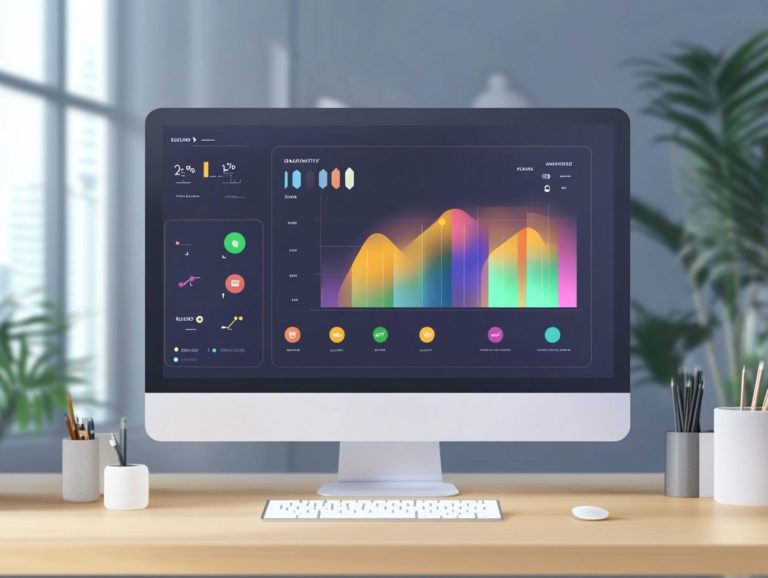How to Choose the Right Performance Management Tool
In today s fast-paced business world, picking the right performance management tool can greatly affect your organization’s success.
With so many options available, it’s vital to understand what these tools offer and how they align with your unique needs.
This article covers important factors to consider, including your business goals, budget, and integration capabilities.
It highlights essential features to look for, empowering you to make an informed choice that boosts productivity and fosters a culture of improvement.
Contents
- Key Takeaways:
- Factors to Consider when Choosing a Performance Management Tool
- Types of Performance Management Tools
- Key Features to Look for in a Performance Management Tool
- Customization Options
- Reporting and Analytics
- User-Friendly Interface
- Frequently Asked Questions
- What factors should I consider when choosing a performance management tool?
- Is it necessary to involve employees in the decision-making process for selecting a performance management tool?
- How do I determine the right performance management tool for my organization?
- Can I customize a tool to manage employee performance according to my organization’s specific needs?
- What are key features to look for in a performance management tool?
- Is it important to consider scalability when selecting such a tool?
Key Takeaways:

- Consider business needs and goals when choosing a performance management tool to ensure it aligns with your company’s objectives.
- Take budget and cost into account, but also consider the value and potential ROI of the tool in the long run.
- Look for key features such as customization options, reporting and analytics, and a user-friendly interface to optimize the tool’s effectiveness and ease of use.
What are Performance Management Tools?
Performance management tools are essential for any organization looking to elevate employee performance and optimize the feedback process. They align individual ambitions with broader organizational objectives.
These tools enable HR professionals and team leaders to monitor performance metrics and conduct insightful performance reviews. They help cultivate a performance-driven culture, which boosts employee engagement and fosters continuous improvement.
By leveraging performance management software, you can analyze performance data and pinpoint training opportunities. You can also set SMART (Specific, Measurable, Achievable, Relevant, Time-bound) goals and craft tailored performance improvement plans that enhance both productivity and employee satisfaction.
Various performance analysis tools offer real-time tracking and benchmarking against industry standards. This allows for more precise assessments of employee contributions. When integrated, these tools make performance review processes structured and consistent.
They often include 360-degree feedback and self-assessments, actively involving employees in their own development. Adopting a coaching mindset can truly enhance relationships between managers and their teams.
This approach promotes open dialogues that encourage constructive feedback and personal growth. Ultimately, these tools drive accountability and nurture an environment of trust and collaboration, transforming performance management into a shared journey toward success.
Factors to Consider when Choosing a Performance Management Tool
When choosing a performance management tool, consider several critical factors, including the key features to look for that cater to your organization’s unique needs.
Key considerations include your specific business needs, budget constraints, and how well the tool can integrate with your existing systems.
Engaging team leaders and HR professionals in this decision-making process is crucial. Their insights will help ensure that the selected performance management system boosts employee performance and engagement, while also fostering effective communication and feedback throughout the organization.
Business Needs and Goals
Understanding your organization’s unique business needs and goals is essential when selecting a performance management tool. Knowing how to use performance management tools for team goals directly impacts employee performance and overall productivity.
A performance management system should seamlessly align with your company’s strategic objectives, tackling performance challenges while fostering employee engagement and development through effective goal setting and performance metrics.
By accurately identifying these needs, you can define performance criteria that clarify expectations and enable employees to contribute meaningfully to collective success. This alignment is key to establishing SMART goals specific, measurable, achievable, relevant, and time-bound that guide employee efforts and underscore accountability.
Regularly analyzing performance against these established benchmarks allows you to adapt strategies to enhance overall performance outcomes. This helps employees understand how their roles contribute to the company’s goals. This proactive approach not only drives results but also promotes ongoing improvement.
Budget and Cost
Budget matters when choosing a performance management tool, as costs can fluctuate considerably depending on functionality and features. It s essential for you as an HR professional to evaluate the total cost of ownership, including subscription fees, training expenses, and potential integration costs.
This ensures that the performance management system you choose aligns with your financial constraints while still delivering substantial value.
Exploring various pricing models whether it s a one-time purchase, subscription-based, or pay-per-use can dramatically influence your overall return on investment. By prioritizing tools that boost employee engagement and retention, you are likely to see an increase in morale and productivity.
Such enhancements not only cultivate a positive workplace culture but also bolster your bottom line over time, as high engagement levels typically result in lower turnover rates and reduced training costs.
A thorough evaluation of these factors will set the stage for a more sustainable and effective performance management strategy.
Integration and Compatibility

When selecting a performance management tool, you must prioritize integration and compatibility. Seamless integration with your existing HR systems can significantly enhance the effectiveness of performance evaluations and feedback processes. Consider using performance management tools for small businesses that easily integrate with other platforms to analyze real-time performance data and improve the overall feedback mechanism.
In today s tech-driven landscape, APIs (Application Programming Interfaces) have become critical for bridging different systems. These are tools that allow different software programs to communicate with each other. They allow for smooth data migration and help reduce those pesky manual entry errors.
This harmonious technical synergy not only ensures that your performance metrics are accurate but also improves employee performance tracking by providing a comprehensive view of their contributions.
The importance of choosing performance management tools that align with various HR systems cannot be overstated. Lacking this compatibility can lead to challenges in streamlining workflows, resulting in inefficiencies and potential delays in performance assessments. Ultimately, selecting the right performance management tools can significantly elevate your user experience, cultivating an environment where feedback is timely, relevant, and actionable.
Types of Performance Management Tools
You’ll find a range of performance management tools at your disposal, each tailored to target specific facets of employee performance and align with organizational objectives.
Tools focused on performance tracking and analysis, feedback and communication, as well as goal setting and progress monitoring, are vital in cultivating a performance-driven culture and enhancing overall employee engagement.
By grasping the nuances of these tools, you can enable yourself as an HR professional to implement effective strategies that boost productivity and achieve key performance indicators.
Performance Tracking and Analysis Tools
Performance tracking and analysis tools are crucial for monitoring employee performance. They help pinpoint areas for improvement.
These powerful tools empower you to collect, analyze, and report on performance metrics. This information offers insights that elevate productivity and enhance performance outcomes.
By leveraging real-time data and visual analytics, you can effortlessly identify trends and patterns that might otherwise slip under the radar. This proactive approach not only sheds light on successful practices but also reveals potential challenges that could impede growth.
With comparative data in your arsenal, you can develop tailored performance improvement plans. This ensures that individual and team efforts align seamlessly with your broader organizational goals.
Ultimately, these tools foster a culture of continuous learning. They enable you to adapt and flourish in an ever-evolving workplace while ensuring that your employees reach their fullest potential.
Feedback and Communication Tools
Feedback and communication tools are essential elements of an effective performance management system. They provide a robust platform for open dialogue between team leaders and employees.
These tools enable you to receive real-time feedback. This fosters continuous improvement and cultivates a culture of employee engagement and performance enhancement.
Among the myriad options available, 360-degree appraisal systems truly shine. They allow colleagues at various levels to share insights and evaluations, creating a comprehensive view of your performance.
Performance calibration methods further enhance this process. They align standards across teams to ensure fairness and consistency in evaluations.
When communication flows seamlessly, it builds trust between management and staff. This significantly elevates employee satisfaction and overall performance outcomes.
By harnessing these innovative feedback tools, you can help cultivate a responsive atmosphere that promotes growth and success for everyone involved.
Goal Setting and Progress Monitoring Tools
Goal setting and progress monitoring tools are essential for aligning your objectives with those of the organization. They ensure that you remain focused on achieving meaningful results.
By implementing SMART goals and leveraging performance management tools, you can effectively track your progress. This enhances performance outcomes.
These approaches clarify what you need to accomplish. They create a structured path for reaching those objectives.
When you see your progress documented through these tools, it fosters a sense of ownership and accountability. Achieving specific, measurable goals ignites your motivation and engagement, resulting in greater productivity.
By integrating ongoing feedback and recognition strategies, you amplify this motivation. This encourages both you and your colleagues to exceed expectations and consistently perform at your best.
This synergy between goal attainment and employee morale ultimately propels the organization toward success.
Key Features to Look for in a Performance Management Tool

Choose a performance management tool that offers key features to elevate the effectiveness of your system. Additionally, explore the benefits of using performance management tools that provide customization options, allowing you to tailor the tool to your organization’s unique needs.
Robust reporting capabilities and advanced analytics are also essential components. They facilitate thorough and effective employee performance evaluations.
Act now to ensure your team thrives!
Customization Options
Customization options in a performance management tool are essential for tailoring your user experience to align seamlessly with how your organization works and performance metrics. The ability to modify features to meet your specific needs can significantly enhance employee engagement and elevate the effectiveness of how employees are assessed on their work.
You stand to gain immensely from this flexibility. It enables you to create workflows that truly reflect your unique operational demands. By adapting reporting formats and performance indicators, you can ensure that evaluations are not just standardized measures, but rather meaningful assessments that resonate with both your team members and leadership.
This personalization nurtures a more dynamic workplace environment where objective insights blend harmoniously with qualitative feedback. Customizing tools allows you to fit the ever-evolving landscape of your business goals and employee aspirations. Ultimately, the entire organization can thrive, harnessing data to drive continuous improvement.
Reporting and Analytics
Robust reporting and analytics capabilities are essential features of any effective performance management tool. They enable you to assess performance data and make informed strategic decisions. Advanced analytics allow HR professionals and team leaders to identify performance trends and derive actionable insights, facilitating ongoing improvements.
These tools not only streamline the data collection process but also enhance the interpretation of complex figures through intuitive dashboards and data visualization. By translating raw data into meaningful graphics, you can easily track employee performance, recognize high achievers, and pinpoint areas needing support.
Data visualization fosters a deeper understanding among team members, promoting a culture of transparency and accountability. These features help you connect individual goals with your organization’s mission, ensuring that every team member contributes effectively to the objectives at hand.
User-Friendly Interface
A user-friendly interface is crucial for any performance management tool. It greatly influences employee engagement and overall usability. When you have an intuitive interface, both HR professionals and employees can navigate the system with ease, leading to more efficient performance evaluations and increased user satisfaction.
As you design these tools, it s vital to incorporate features like customizable dashboards, real-time feedback capabilities, and easy access to performance metrics. These components streamline the evaluation process and enable employees to take ownership of their development.
By enabling mobile accessibility, you allow users to engage with the platform anytime, anywhere, enhancing their overall experience. By prioritizing design and usability, your organization can cultivate a culture of continuous feedback and improvement, ultimately driving higher productivity and satisfaction among team members.
Frequently Asked Questions
What factors should I consider when choosing a performance management tool?

When choosing a performance management tool, consider factors such as the specific needs and goals of your organization, the features and functionalities of the tool, its user-friendliness, cost, and customer support.
Is it necessary to involve employees in the decision-making process for selecting a performance management tool?
Involving employees in the decision-making process can be beneficial. It allows them to provide valuable insights and feedback on their needs and preferences, leading to better adoption and usage of the tool.
How do I determine the right performance management tool for my organization?
To determine the right performance management tool, assess your organization’s current performance management process. Identify areas for improvement, then research and compare different tools that align with your needs. Consider key considerations for performance management tool adoption to select the one that best fits your requirements.
Can I customize a tool to manage employee performance according to my organization’s specific needs?
Many tools for managing employee performance offer options to fit the unique needs of organizations, and exploring performance management tools can be a great starting point.
Before you choose a tool, ask about how it can be customized for you.
What are key features to look for in a performance management tool?
Look for features like goal-setting, tracking, real-time feedback, performance reviews, and reporting.
Integration with other HR systems is also essential.
Is it important to consider scalability when selecting such a tool?
Yes! It’s crucial to consider scalability when choosing a performance management tool.
Your tool should grow with your organization and adapt as your needs change.





